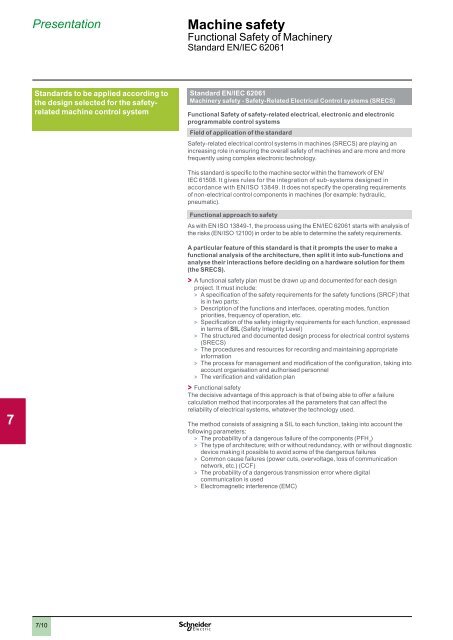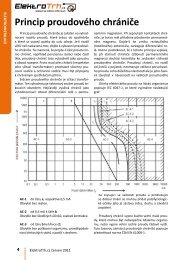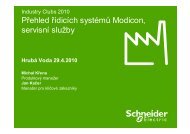2 - Schneider Electric CZ, s.r.o.
2 - Schneider Electric CZ, s.r.o.
2 - Schneider Electric CZ, s.r.o.
Create successful ePaper yourself
Turn your PDF publications into a flip-book with our unique Google optimized e-Paper software.
Presentation<br />
Machine safety<br />
Functional Safety of Machinery<br />
Standard EN/IEC 62061<br />
1<br />
2<br />
3<br />
4<br />
5<br />
6<br />
7<br />
8<br />
Standards to be applied according to<br />
the design selected for the safetyrelated<br />
machine control system<br />
Standard EN/IEC 62061<br />
Machinery safety - Safety-Related <strong>Electric</strong>al Control systems (SRECS)<br />
Functional Safety of safety-related electrical, electronic and electronic<br />
programmable control systems<br />
Field of application of the standard<br />
Safety-related electrical control systems in machines (SRECS) are playing an<br />
increasing role in ensuring the overall safety of machines and are more and more<br />
frequently using complex electronic technology.<br />
This standard is specific to the machine sector within the framework of EN/<br />
IEC 61508..It gives rules for the integration of sub-systems designed in<br />
accordance with EN/ISO 13849..It does not specify the operating requirements<br />
of non-electrical control components in machines (for example: hydraulic,<br />
pneumatic).<br />
Functional approach to safety<br />
As with EN ISO 13849-1, the process using the EN/IEC 62061 starts with analysis of<br />
the risks (EN/ISO 12100) in order to be able to determine the safety requirements.<br />
A particular feature of this standard is that it prompts the user to make a<br />
functional analysis of the architecture, then split it into sub-functions and<br />
analyse their interactions before deciding on a hardware solution for them<br />
(the SRECS).<br />
> > A functional safety plan must be drawn up and documented for each design<br />
project. It must include:<br />
> > A specification of the safety requirements for the safety functions (SRCF) that<br />
is in two parts:<br />
> > Description of the functions and interfaces, operating modes, function<br />
priorities, frequency of operation, etc.<br />
> > Specification of the safety integrity requirements for each function, expressed<br />
in terms of SIL (Safety Integrity Level)<br />
> > The structured and documented design process for electrical control systems<br />
(SRECS)<br />
> > The procedures and resources for recording and maintaining appropriate<br />
information<br />
> > The process for management and modification of the configuration, taking into<br />
account organisation and authorised personnel<br />
> > The verification and validation plan<br />
> > Functional safety<br />
The decisive advantage of this approach is that of being able to offer a failure<br />
calculation method that incorporates all the parameters that can affect the<br />
reliability of electrical systems, whatever the technology used...<br />
The method consists of assigning a SIL to each function, taking into account the<br />
following parameters:<br />
> > The probability of a dangerous failure of the components (PFH d<br />
)<br />
> > The type of architecture; with or without redundancy, with or without diagnostic<br />
device making it possible to avoid some of the dangerous failures<br />
> > Common cause failures (power cuts, overvoltage, loss of communication<br />
network, etc.) (CCF)<br />
> > The probability of a dangerous transmission error where digital<br />
communication is used<br />
> > Electromagnetic interference (EMC)<br />
9<br />
10<br />
7/10
















